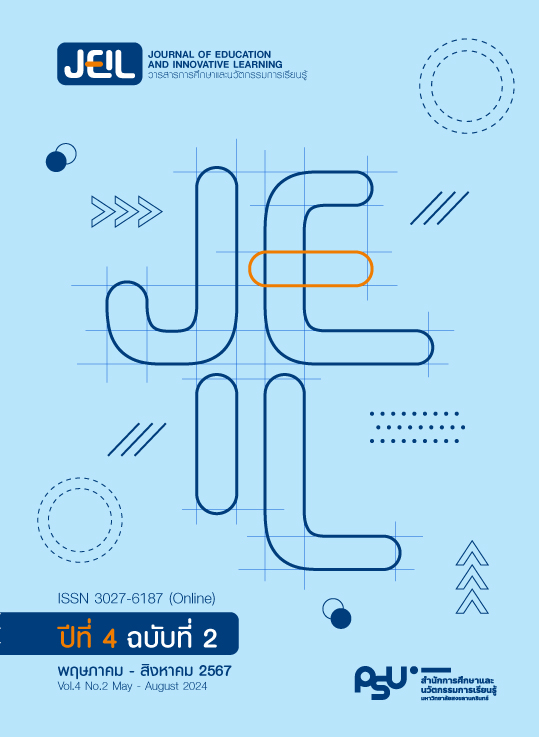Developing Attitudes Toward Medical Professionalism: the 10 Virtues of The King Principle through Group Discussion Learning Among Second-Year Medical Students in Medical Ethics
Main Article Content
Abstract
The objective of this research was to compare the mean scores of attitudes toward medical professionalism before and after teaching the 10 virtues of the King principle through group discussion learning. Additionally, the study aimed to apply those 10 virtues of the King leading to the development of attitudes toward medical professionalism from the perspective of second-year medical students. The target population consisted of 48 second-year medical students during the first semester of the academic year 2022, at Siam University. The research utilized a one-group pretest-posttest quasi-experimental design, involving the development of activities and creation of teaching tools. The instruments used collected data on the attitudes towards medical professionalism questionnaire and focus group discussion. The results were analyzed by descriptive statistics. The results of the study showed that the mean scores for attitudes toward medical professionalism in all aspects were 171.2±12.1 before learning and 182.5±9.2 after learning. The percentage of learner development was recorded as high, at 52.5%. From the perspective of medical students, 6 of the 10 virtues of the King principle are charity, sacrifice, honesty, gentleness, perseverance, and non-violence, and these virtues contribute to the development of attitudes toward medical professionalism. Therefore, teaching about medical professionalism in the form of discussing the 10 virtues of the King principle through group discussion aids in developing proper attitudes for medical professionalism among second-year medical students.
Article Details

This work is licensed under a Creative Commons Attribution-NonCommercial-NoDerivatives 4.0 International License.
The contents and data in published articles in the Journal of Education and Innovative Learning are considered the ideas and responsibility of the author(s). The Editorial team does not necessarily agree with any ideas or hold mutual responsibility of them. Plagiarism is not permitted, even for academic purposes. However, proper citation must be given whenever referencing the articles.
References
Amatyakul, P. (2019). Attitude of clinical clerkship medical students towards learning method of medical ethics in Obstetrics and Gynecology. Buddhachinaraj Medical Journal, 36(3), 303-311. Retrieved from https://he01.tci-thaijo.org/index.php/BMJ/article/view/243499 [in Thai]
Bashir, A., & McTaggart, I. J. (2022). Importance of faculty role modeling for teaching professionalism to medical students: Individual versus institutional responsibility. Journal of Taibah University Medical Sciences, 17(1), 112-119. doi:10.1016/j.jtumed.2021.06.009
Blank, L., Kimball, H., McDonald, W., & Merino, J. (2003). Medical professionalism in the new millennium: a physician charter 15 months later. Annals of Internal Medicine, 138(10), 839-841. doi:10.7326/0003-4819-138-10-200305200-00012
Cruess, R. L., Cruess S. R., & Johnston S. E. (2000). Professionalism: an ideal to be sustained. The Lancet, 356(9224), 156-159. doi:10.1016/S0140-6736(00)02458-2
Cusimano, M. C., Ting, D. K., Kwong, J. L., Van Melle, E., MacDonald, S. E., & Cline, C. (2019). Medical students learn professionalism in near-peer led, discussion-based small groups. Teaching and Learning in Medicine, 31(3), 307-318. doi:10.1080/10401334.2018.1516555
Engchuan, K., & Chinwanno, W. (2019). Ethics of the physicians working at the government hospitals in Thailand. Journal of Humanities and Social Sciences Thonburi University, 13(1), 119-129. Retrieved from https://so03.tci-thaijo.org/index.php/trujournal/article/view/166669 [in Thai]
General Medical Council. (2023). Good medical practice. Retrieved from https://www.gmc-uk.org/-/media/documents/good-medical-practice---english-20200128_pdf-51527435.pdf
Harvey, S. (2013). A different perspective: the multiple effects of deep level diversity on group creativity. Journal of Experimental Social Psychology, 49(5), 822-832. doi:10.1016/j.jesp.2013.04.004
Kammanee, T. (2010). Science of teaching: Knowledge for efficient learning process management. (13th ed.). Bangkok: Chulalongkorn University Printing. [in Thai]
Kanchanawasi, S. (2013). Classical test theory. Bangkok: Chulalongkorn University Press. [in Thai]
Kittinon, K., Chamnanvanakij, S., Pimparyon, P., & Saengaroon P. (2015). Perceptions of medical students on medical ethics teaching at Phramongkutklao College of Medicine. Royal Thai Army Medical Journal, 68(2), 79-85. Retrieved from https://he02.tci-thaijo.org/index.php/rtamedj/article/view/59615 [in Thai]
Kohlberg, L. (1976). Moral stages and moralization: The cognitive developmental approach. In L. Lickona (Ed.), Moral development and behavior: Theory research, and social issues (29-31). New York, NY: Holt, Rinehart and Winston.
Levey, N. N. (2015). Medical professionalism and the future of public trust in physicians. Journal of the American Medical Association, 313(18), 1827-1828. doi:10.1001/jama.2015.4172
Morgenroth, T., Ryan, M. K., & Peters, K. (2015). The motivational theory of role modeling: how role models influence role aspirants’ goals. Review of General Psychology, 19(4), 465-483. doi:10.1037/gpr0000059
Papadakis, M. A., Teherani, A., Banach, M. A., Knettler, T. R., Rattner, S. L., & Stern, D. T., … Hodgson, C. S. (2005). Disciplinary action by medical boards and prior behavior in medical school. The New England Journal of Medicine, 353(25), 2673-2682. doi:10.1056/NEJMsa052596
Parthiban, N., Boland, F., Fadil Azim, D. H., Pawlikowska, T., O'Shea, M. T., Jaafar, M. H., & Morgan, K. (2021). Asian medical students' attitudes towards professionalism. Medical Education Online, 26(1), 1-8. doi:10.1080/10872981.2021.1927466
Phutathum, S., Kiatrungrit, K., Hongsanguansri, S., & Kolkijkovin, V. (2021). Association between grit and medical professionalism among medical students and related factors. Journal of the Psychiatric Association of Thailand, 66(1), 81-96. Retrieved from https://he01.tci-thaijo.org/index.php/JPAT/article/view/245368 [in Thai]
Shayakul, C. (2012). Medical Professionalism. In C. Shayakul, K. Wirakul, R. Praditsuwan, & W. Thongtang, (Eds.), Medical Ethics. (37-51). Bangkok: October Printing House. [in Thai]
Sukumalpaiboon, P., Ittiphanitphong, C., Sutpasanon, T., & Thanbuasawan, D. (2018). Which virtues of the King applicable to teach medical ethics and professionalism?. Journal of Prapokklao Hospital Clinical Medicine Education Center, 35(4), 372-382. Retrieved from https://he02.tci-thaijo.org/index.php/ppkjournal/article/view/154360 [in Thai]
Sumalrot, T., Supparerkchaisakul, N., & Ngamthipwatthana, T. (2018). Medical professionalism: Development and validation of medical professionalism scale (MPS). Journal of Behavioral Science for Development, 10(1), 126-145. Retrieved from https://so02.tci-thaijo.org/index.php/JBSD/article/view/91624 [in Thai]
Theerawitthayalert, P. (2016). Effective focus group technique. Journal of Yanasangvorn Research Institute Mahamakut Buddhist University, 7(2), 284-289. Retrieved from https://so04.tci-thaijo.org/index.php/yri/article/view/184932 [in Thai]
Theerawitthayalert, P. (2018). Classroom action research and research ethics. Journal of Chandrakasemsarn, 24(47), 33-47. Retrieved from https://li01.tci-thaijo.org/index.php/crujournal/article/view/160318 [in Thai]
West, R., & Turner, L. H. (2014). Introducing communication theory: analysis and application (5th ed.). New York, NY: McGraw-Hill.

